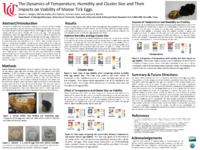Dynamics of Temperature, Humidity, and Clutch Size on Viability of Moose Tick Eggs
Main Article Content
Abstract
By Derek Herges, Biological Sciences
Advisor: Joshua Benoit
Presentation ID: 270
Abstract: The moose or winter tick, Dermacentor albipictus, is a one-host species, feeding on moose and other ungulates. Most ticks spend a majority of their lives off-host, but as a one host species, the only stages off-host are the eggs and larvae. In specific, females will feed on a host, and then detach to lay their eggs in the surrounding environment, where the eggs will hatch and the larvae will then quest for the next host. This indicates that where the female ticks lay their eggs is vital to their survival as a population since the eggs must be able to thrive in the environment where deposited. Little is known about the effects of temperature, humidity, and clutch size on the viability of winter tick eggs. In this experiment, we investigate how these dynamics between the specific relative humidity, temperature, and clutch size affect the survivability of D. albipictus eggs. Our data shows that the best conditions for moose tick egg survivability are in larger groups of eggs, at higher humidity, and under lower temperatures allowing the moose tick eggs to retain high viability in areas with these conditions. These studies on D. albipictus eggs are particularly of interest due to the lack of knowledge about the survivability of the tick within various environments.
